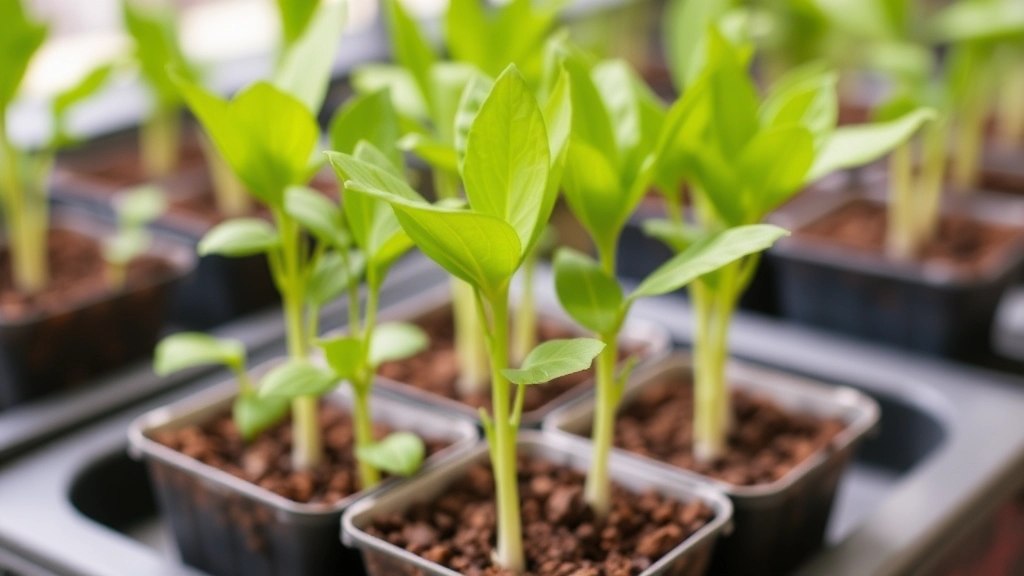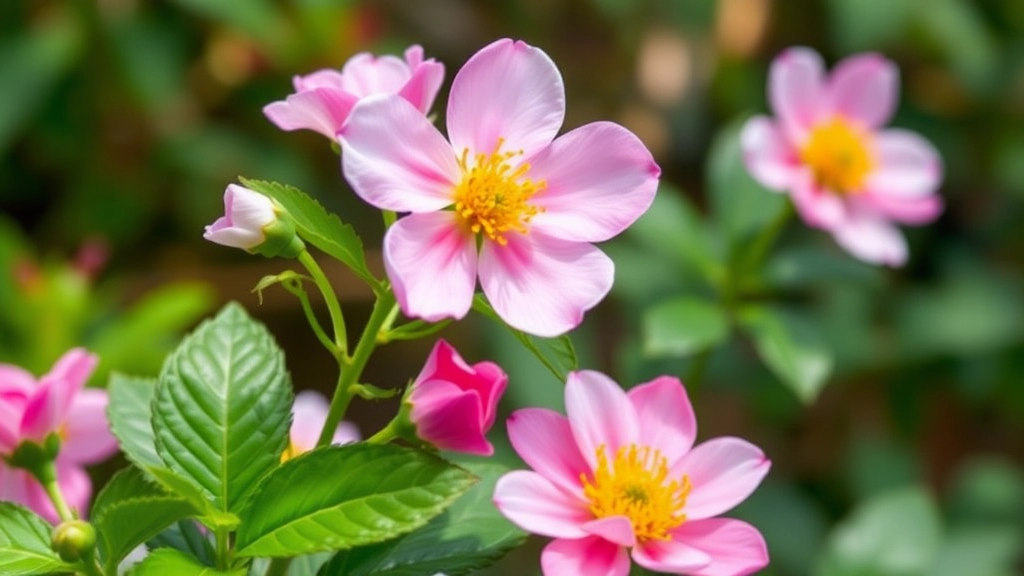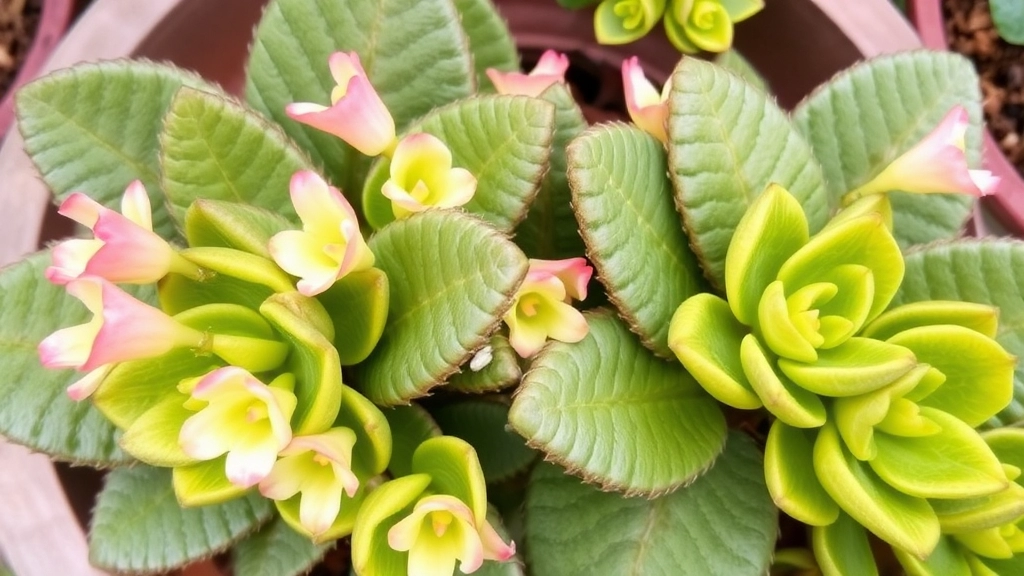Cultivating Kalanchoe Hybrid Behartii
When it comes to cultivating a Kalanchoe Hybrid Behartii, understanding the best growing conditions is key. This unique succulent thrives in well-draining soil and requires moderate watering, making it a low-maintenance favourite among plant enthusiasts. Whether you’re growing it indoors or outdoors, ensuring it gets plenty of indirect sunlight will keep its scalloped, silver-grey leaves vibrant and healthy.
Propagation
Propagation of Kalanchoe Hybrid Behartii can be a rewarding process, often achieved through leaf cuttings. For optimal success, allow the cuttings to dry out before planting them in a suitable potting mix. Regularly check for common pests like aphids and mealybugs to keep your plant thriving. With the right care, this compact, shrubby succulent can be a stunning addition to any garden or indoor space.
Best Growing Conditions for Kalanchoe Hybrid Behartii
Are you struggling to keep your Kalanchoe Hybrid Behartii thriving?
Understanding the best growing conditions for this vibrant succulent can make all the difference.
Ideal Environment
Kalanchoe Hybrid Behartii flourishes in conditions that mimic its native habitat.
- Temperature: Aim for a consistent temperature between 18°C to 24°C.
- Humidity: Moderate humidity levels are ideal. Too much moisture can lead to rot.
Sunlight Needs
Light is crucial for the health of your Kalanchoe.
- Bright Indirect Light: Position your plant where it can soak up bright, indirect sunlight for about 6 hours a day.
- Avoid Direct Sunlight: Direct sunlight can scorch the leaves, so a sheer curtain can help filter the light.
Watering Practices
Watering is often where many plant owners go wrong.
Light and Watering Requirements for Indoor and Outdoor Growth

So, you’ve got your Kalanchoe Hybrid Behartii, and you’re wondering how to keep it thriving.
Let’s dive into the light and watering needs that can make or break your plant’s happiness.
Light Requirements
Kalanchoe loves bright light, but it’s not a fan of direct sunlight for long periods.
Here’s what you need to know:
- Indoor Growth: Place your Kalanchoe near a window where it can soak up bright, indirect light. A south-facing window is ideal.
- Outdoor Growth: If you’re keeping it outside, find a spot that gets morning sun and afternoon shade. Too much direct sun can scorch those lovely leaves.
- Signs of Too Little Light: If your plant starts looking leggy or the leaves lose their vibrant colour, it’s a sign it needs more light.
Watering Requirements
Now, let’s chat about watering. This is where many folks go wrong.
- Frequency: Water your Kalanchoe when the top inch of soil feels dry. Typically, this means watering every 2-3 weeks, but it can vary based on your climate and season.
- Method: When you water, give it a good soak until water drains from the bottom of the pot. But don’t let it sit in water; that’s a recipe for root rot.
- Signs of Overwatering: Yellowing leaves? That’s a red flag! Scale back on the watering if you see that.
- Signs of Underwatering: If the leaves start to wrinkle or shrivel, it’s time to give your plant a drink.
When it comes to growing Kalanchoe hybrid Behartii, the right soil and potting mix can make all the difference. Many plant enthusiasts often ask, “What type of soil is best for my Kalanchoe?”
Kalanchoe thrives in well-draining soil that mimics its native arid environment. Here are some key components to consider:
– **Cactus Mix**: A pre-mixed cactus or succulent soil is ideal. It allows for proper drainage while retaining enough moisture for the plant’s needs.
– **Perlite or Pumice**: Adding perlite or pumice to your potting mix enhances aeration and drainage. Aim for a mix that is approximately 50% cactus mix and 50% perlite or pumice.
– **Organic Matter**: Incorporating some organic matter, like compost, can provide essential nutrients. However, avoid overly rich soils that retain too much moisture.
Selecting the right pot is just as crucial:
– **Drainage Holes**: Always choose pots with drainage holes to prevent water from accumulating at the bottom, which can lead to root rot.
– **Size**: Opt for a pot that is slightly larger than the root ball of your Kalanchoe. This allows for growth without overwhelming the plant.
– **Material**: Terracotta pots are a great choice as they are porous and help wick away excess moisture.
By ensuring your Kalanchoe is planted in the right soil and potting mix, you set the stage for vibrant growth and blooming. For more detailed guidance, you might find the [complete care guide for Kalanchoe humilis succulent](https://planthq.org/complete-care-guide-for-kalanchoe-humilis-succulent/) helpful. Additionally, understanding [why Kalanchoe plant leaves turn brown](https://planthq.org/why-kalanchoe-plant-leaves-turn-brown-causes-solutions/) can help you troubleshoot common issues.
IV. Propagation Techniques for Maximum Success

When it comes to propagating Kalanchoe hybrid Behartii, many enthusiasts wonder about the best methods to ensure their plants thrive.
Understanding Propagation Methods
Propagation can be an exciting way to expand your plant collection. Here are the most effective techniques:
- Leaf Cuttings:
- Select healthy leaves from the parent plant.
- Allow the cut ends to dry for a few hours to form a callus.
- Place the cuttings in well-draining soil and water sparingly until roots develop.
- Stem Cuttings:
- Choose a stem with several leaves.
- Cut just below a node and let it dry for a day.
- Place in soil and water lightly until roots appear.
- Offsets:
- Look for small plants growing at the base of the parent plant.
- Gently separate them and plant them in their own pots.
Tips for Successful Propagation
To increase your chances of success, consider the following tips:
- Timing:
- The best time to propagate is during the growing season, typically spring or summer.
- Environment:
- Keep cuttings in a warm, bright location but out of direct sunlight to prevent scorching.
- Humidity:
- A humidity dome or plastic bag can help retain moisture but ensure good airflow to prevent rot.
- Patience:
- Rooting can take a few weeks, so be patient and avoid overwatering during this period.
By mastering these propagation techniques, you can enjoy a flourishing collection of Kalanchoe hybrid Behartii.
As we explore the best practices for caring for Kalanchoe hybrid Behartii, it’s crucial to address the potential threats posed by pests.
### Identifying Common Pests
Kalanchoe plants can fall victim to various pests that may hinder their growth and overall health. Here are some of the most common culprits:
– **Aphids**: Small, green or black insects that suck sap from the leaves.
– **Mealybugs**: White, cottony pests that cluster in leaf axils and on stems.
– **Spider Mites**: Tiny, red or brown pests that create fine webbing on leaves.
– **Scale Insects**: Hard, shell-like pests that attach themselves to stems and leaves.
### Prevention Strategies
Preventing infestations is far easier than dealing with them once they occur. Here are some effective strategies:
– **Regular Inspections**: Check your plants weekly for any signs of pests.
– **Cleanliness**: Keep the area around your plants tidy to deter pests.
– **Proper Watering**: Overwatering can lead to root rot and attract pests. Ensure your Kalanchoe is well-drained.
– **Companion Planting**: Consider planting pest-repelling plants nearby, such as marigolds.
– **Neem Oil**: This natural pesticide can deter pests without harming your plant.
By implementing these preventive measures, you can significantly reduce the risk of infestations.
### Dealing with Infestations
If you do encounter pests, here are some steps to take:
1. **Isolate Affected Plants**: Prevent the spread to healthy plants.
2. **Manual Removal**: Use a cotton swab dipped in alcohol to remove mealybugs and scale insects.
3. **Insecticidal Soap**: Spray on affected areas to eliminate pests effectively.
4. **Regular Maintenance**: Prune any dead or infested leaves to promote healthy growth.
Taking these actions will help maintain the vitality of your Kalanchoe hybrid Behartii. For more detailed care tips, you can check out our [care tips for a fully grown Kalanchoe plant](https://planthq.org/care-tips-for-a-fully-grown-kalanchoe-plant/) and learn about [common issues with Kalanchoe leaves](https://planthq.org/kalanchoe-leaf-problems-causes-solutions-and-prevention/).
Tips for Flowering and Seasonal Care

So, you’ve got your Kalanchoe Hybrid Behartii thriving, but how do you encourage those beautiful blooms?
Let’s dive into some straightforward tips that’ll help your plant flourish throughout the seasons.
Flowering Tips
- Light Exposure: Make sure your plant gets bright, indirect sunlight. Too much direct sun can scorch the leaves, while too little light can hinder flowering. Aim for about 6 hours of light daily.
- Temperature Check: Kalanchoes love warmth. Keep them in a cozy spot, ideally between 18-24°C (65-75°F). They can tolerate a bit cooler at night, but avoid drafts!
- Water Wisely: During the flowering phase, keep the soil slightly moist. Let it dry out between waterings, but don’t let it become bone dry. Overwatering can lead to root rot, which is a real buzzkill.
- Fertilisation: Use a balanced fertiliser every 4-6 weeks during the growing season. A high-phosphorus fertiliser can encourage more blooms. Just remember, too much can be harmful!
- Prune After Blooming: Once the flowers fade, give your plant a little trim. This encourages new growth and can help set up for another blooming cycle down the line.
Seasonal Care
- Winter Care: In colder months, reduce watering. Your Kalanchoe will enter a dormant phase, so it doesn’t need as much moisture. Keep it in a well-lit area to help it through the chill.
- Summer Strategies: If it’s scorching outside, consider moving your plant to a shadier spot during the hottest parts of the day. This helps prevent leaf burn.
- Humidity Levels: Kalanchoes prefer low humidity. If you’re in a humid area, ensure good air circulation around your plant to prevent fungal issues.
- Repotting: If your plant outgrows its pot, repot it during the spring. Choose a slightly larger pot with fresh soil to give it room to grow.
When considering the versatility of Kalanchoe hybrid Behartii, one might wonder how best to incorporate this stunning succulent into both indoor and outdoor spaces.
### Landscaping Applications
Kalanchoe hybrid Behartii can be a game-changer in landscaping due to its vibrant flowers and unique foliage. Here are some effective ways to use it:
– **Rock Gardens:** Their drought-resistant nature makes them perfect for rock gardens, adding a splash of colour amidst stones.
– **Border Edges:** Use them as border plants to create a striking contrast with other perennials and shrubs.
– **Container Gardens:** They thrive in pots, allowing for creative arrangements on patios or balconies.
– **Xeriscaping:** Ideal for low-water gardens, they contribute to sustainable landscaping practices.
### Indoor Decoration
Bringing Kalanchoe hybrid Behartii indoors can enhance your living space with its aesthetic appeal. Consider these ideas:
– **Table Centrepieces:** Their vibrant blooms can serve as eye-catching centrepieces for dining or coffee tables.
– **Windowsills:** Positioning them on windowsills allows them to soak up sunlight while brightening up your home.
– **Shelf Displays:** Grouping them with other succulents can create a stunning shelf display.
– **Office Spaces:** Their low-maintenance nature makes them perfect for brightening up office environments.
Incorporating Kalanchoe hybrid Behartii into your landscaping or home decor not only adds beauty but also promotes a sense of tranquility. For more tips on creating stunning **container gardens** with Kalanchoe, check out our [guide on growing Kalanchoe in flower beds](https://planthq.org/growing-kalanchoe-in-flower-beds-care-tips-and-best-practices/). Additionally, if you’re curious about other varieties of Kalanchoe, our [Kalanchoe succulent identification guide](https://planthq.org/kalanchoe-succulent-identification-guide-top-varieties-traits/) can help you explore top varieties and traits.
Maintaining Healthy Growth in Cold and Warm Climates
When it comes to keeping your Kalanchoe hybrid Behartii thriving, the weather can be a real game-changer.
Cold Climates
If you live in a chillier area, you might be wondering how to keep your plant happy when temperatures drop. Here are some tips:
- Bring It Indoors: As soon as the temperature dips below 10°C (50°F), it’s time to move your Kalanchoe inside.
- Avoid Drafts: Keep it away from cold windows and doors. Drafts can stress the plant.
- Humidity Matters: Use a humidifier or place a tray of water nearby to maintain humidity levels.
- Monitor Watering: In winter, your plant needs less water. Check the soil before watering to avoid overdoing it.
Warm Climates
On the flip side, if you’re basking in the sun, your Kalanchoe needs some special care too:
- Shade is Key: During the hottest part of the day, provide some shade to prevent leaf burn.
- Water Wisely: Warm weather means your plant will need more water, but ensure it drains well. Overwatering can lead to root rot.
- Fertilize: Use a diluted, balanced fertilizer every few weeks during the growing season to give it that extra boost.
General Tips for Both Climates
- Check for Pests: Warm weather can invite unwanted guests. Regularly inspect your plant for pests and treat them immediately.
- Rotate Your Plant: If it’s indoors, rotate it every few weeks to ensure even growth.
For more detailed guidance, you can refer to our Ultimate Guide to Growing and Caring for Succulent Plant Kalanchoe and learn about why Kalanchoe leaves might be dying and how to solve it.
FAQs on Kalanchoe Hybrid Behartii
What kind of light does Kalanchoe Hybrid Behartii require?
Kalanchoe Hybrid Behartii thrives in bright, indirect light. For indoor growth, place it near a window, preferably a south-facing one. For outdoor growth, ensure it gets morning sun and afternoon shade to prevent leaf scorching.
How often should I water my Kalanchoe Hybrid Behartii?
Water your Kalanchoe when the top inch of soil feels dry, typically every 2-3 weeks. Make sure to water thoroughly until it drains from the bottom, but avoid letting the plant sit in water to prevent root rot.
What are the signs of overwatering and underwatering?
Overwatering can cause yellowing leaves, while underwatering may lead to wrinkled or shriveled leaves. Adjust your watering habits accordingly if you notice these signs.
How can I propagate Kalanchoe Hybrid Behartii?
You can propagate Kalanchoe Hybrid Behartii through leaf cuttings, stem cuttings, or offsets. Ensure you allow cut ends to dry and form a callus before planting in well-draining soil.
When is the best time to propagate Kalanchoe Hybrid Behartii?
The ideal time to propagate is during the growing season, typically in spring or summer. This ensures better rooting and growth.
How do I encourage my Kalanchoe Hybrid Behartii to flower?
Ensure your plant gets about 6 hours of bright, indirect sunlight daily. Maintain a warm temperature between 18-24°C (65-75°F), and keep the soil slightly moist during the flowering phase. Use a balanced fertiliser every 4-6 weeks during the growing season.
What should I do after my Kalanchoe Hybrid Behartii finishes blooming?
After the flowers fade, prune your plant to encourage new growth and set it up for another blooming cycle.
How should I care for my Kalanchoe Hybrid Behartii during winter?
Reduce watering in winter as the plant enters a dormant phase. Keep it in a well-lit area to help it through the colder months.
What are the summer care tips for Kalanchoe Hybrid Behartii?
During hot weather, move your plant to a shadier spot to prevent leaf burn. Ensure good air circulation to keep humidity levels low and prevent fungal issues.
When and how should I repot my Kalanchoe Hybrid Behartii?
Repot your plant in spring if it outgrows its pot. Choose a slightly larger pot with fresh soil to give it room to grow.
References
-
Kalanchoe Plant Care Guide
-
Gardening Know How: Kalanchoe Care
-
The Old Farmer’s Almanac: Kalanchoe
